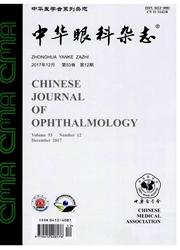

 中文摘要:
中文摘要:
目的探讨激光诱发小鼠脉络膜新生血管(CNV)后,骨髓来源细胞(BMC)在其眼部的表型特征。方法实验研究。以绿色荧光蛋白(GFP)转基因小鼠为供体,野生型C57BL/6J小鼠为受体进行骨髓移植后,应用532nm倍频激光对嵌合子小鼠(处理组)和野生型小鼠(对照组)的右眼进行光凝,建立CNV模型,应用荧光素眼底血管造影和组织病理学分析确定模型稳定后,对实验眼进行免疫荧光染色,观察GFP阳性细胞在眼部的表型特征。结果激光照射后14dCNV生长趋于稳定,此时GFP阳性细胞分布于CNV区域(包括CNV深层的脉络膜)、CNV表层的视网膜、角巩膜缘、睫状体、视乳头周围及远离CNV的视网膜、脉络膜和巩膜。CD31或αSMA阳性的GFP+细胞仅出现于CNV区域,F4/80和GFP双阳性的细胞不仅出现在CNV区域,还出现在CNV表层的视网膜、角巩膜缘和睫状体。结论分化为血管细胞的BMC可特异性向CNV区域趋化,出现在眼部其他区域的BMC中有部分是巨噬细胞或树突状细胞。BMC在眼部除参与CNV形成外,可能还有其他功能。
 英文摘要:
英文摘要:
Objective To investigate the phenotype feature of bone marrow-derived cells in mice's eyes after induction of choroidal neovascularization by laser photocoagulation. Methods It was a experimental study. Green fluorescent protein (GFP) chimeric mice were developed by transplanting bone marrow cells from GFP +/+ transgenic mice to adult C57BL/6J mice. The chimeric mice underwent laser rupture of Bruch membrane to induce CNV. Fluorescein fundus angiography and histopathological study were used to confirm the stable formation of CNV. Then the eyes were enucleated and processed for to detect the distribution and phenotype of GFP + cells. Results The development of CNV has stabled by the 142 day after lasering. GFP-labelled cells appeared in CNV lesions (including choroid beneath CNV lesion), neurosensory retina over CNV, corueoscleral limbus, ciliary body, optic disc and sclera, retina and choroid distant from CNV. GFP + cells, which were immunoreactive for otSMA or CD31, appeared in lesions only. However, 174/80 + green cells can be also detected in neurosensory retina over CNV, corueoscleral limbus and ciliary body. Conclusions BMC which differentiated into vascular cells presented in CNV lesions only. Some BMC appearing in other positions might be macrophages or dendritic cells. There may be other functions apart from contributing to choroidal neovascularization for BMC in the eyes. (Chin J Ophthalmol , 2008,44:212-216)
 同期刊论文项目
同期刊论文项目
 同项目期刊论文
同项目期刊论文
 Role of PI3K/Akt and MEK/ERK in Mediating Hypoxia-Induced Expression of HIF-1 alpha and VEGF in Lase
Role of PI3K/Akt and MEK/ERK in Mediating Hypoxia-Induced Expression of HIF-1 alpha and VEGF in Lase Choroidal neovascularization in age-related macular degeneration depends on vascular endothelial gro
Choroidal neovascularization in age-related macular degeneration depends on vascular endothelial gro Inhibitory Efficacy of Hypoxia-inducible factor 1α Short Hairpin RNA Plasmid DNA loaded Poly (D, L-l
Inhibitory Efficacy of Hypoxia-inducible factor 1α Short Hairpin RNA Plasmid DNA loaded Poly (D, L-l Inhibition of proliferation, migration and tube formation of choroidal microvascular endothelial cel
Inhibition of proliferation, migration and tube formation of choroidal microvascular endothelial cel Nicotine promotes contribution of bone marrow-derived cells to experimental choroidal neovasculariza
Nicotine promotes contribution of bone marrow-derived cells to experimental choroidal neovasculariza 期刊信息
期刊信息
